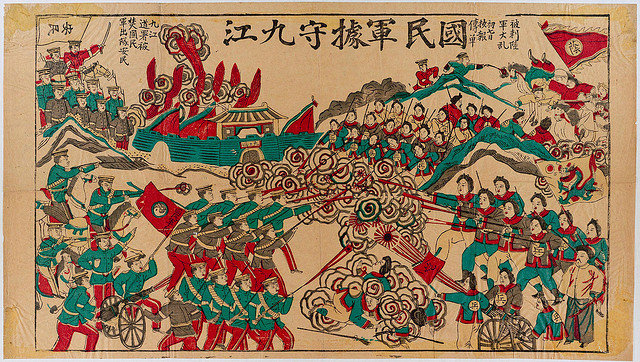Written By: Emily Wilson
Posted on September 30, 2019
The “Xinhai Revolution” of October 1911, it is often held, gave birth to modern China. The imperial bureaucracy that had been entrenched since 221 BC and that arguably was transitioning towards a constitutional monarchy was toppled. In January of 1912, the Republic of China was formally established, with the emperor being replaced by a president.
In a recent talk at Allard Law’s Centre for Asian Legal Studies, the economic historian James Kung from Hong Kong University presented important new research on the catalysts of this historic event. Professor Kung notes that ideology and elites in general play indispensable roles in revolutions: an average of 75% of leaders in major revolutions since the 19th century were from the upper class, and an average of 89% of such revolutions were inspired by democratic ideology. His new study investigates how two types of elites, and a particular source of revolutionary ideology, contributed to the Xinhai Revolution.
Professor Kung defines “traditional elites” as the group of individuals that accomplished the uncommon feat of succeeding in the Chinese civil exam (many reaching the rank of jinshi and juren) and entered the government bureaucracy in the 19th century. These individuals (such as Zeng Guofan, Zuo Zongtong, and Zhang Zhidong) amassed substantial governmental and business resources and established a political party known as the Constitutionalists to protect their own business interests. However, they initially tried to advance their interests within the Qing regime, and subsequently played only a supporting (albeit crucial) role in the 1911 revolution.
Professor Kung posits that the revolution of 1911 was triggered by “new elites”, who were largely spawned in Japan (and included Sun Yat-Sen, Huang Xin, Tao Cheng-Zhang and others). During the decade before 1911, Chinese citizens were publicly and privately sponsored to study at Japanese post-secondary institutions. While these individuals were often the relatives of the traditional elites, they differ from the latter in having been exposed to what one might call an ideological “treatment”: witnessing modernity and experiencing the freedom of thought in Japan made compromises with the dynastic rulers unacceptable. The new elites thus shunned the imperial political paradigm, advocating for the democratic values they were exposed to during their studies.
Professor Kung proposes a particular way of identifying the causal impact of these elites on the outburst of revolution. He gathered data on returned overseas Chinese students with at least a postsecondary degree from Japan (fewer than 3000 individuals enrolled in such lengthy programs) as a proxy for new elites. Members of the Constitutionalist party from 1895 to 1911 are likewise used as a proxy for traditional elites. Professor Kung then examines the distribution of these two types of elites along a geographical demarcation that played no direct role in the 1911 Revolution. The Yangtze Compact was an agreement made by five viceroys in southeast China in 1900 to prevent an assault from the Boxer Rebellion; it ended in 1901 after a peace agreement was made. Provinces in the Yangtze Compact took the lead in promoting modernization, and therefore new elites were more inclined to go to these provinces. Similarly, Yangtze Compact provinces were where the traditional elites predominated.
Professor Kung studied the relative frequencies of rebellions in 1911, and the subsequent declarations of independence from the Qing, in the adjacent prefectures along the boundary demarcating the Yangtze Compact. This is an instance of “spatial regression discontinuity design”: the prefectures on the two sides of the boundary have much in common, yet they differed in both the frequency of elites and the frequency of the rebellions. Since the boundary itself played no role in the 1911 revolution, differences in the frequency of rebellions among border prefectures can plausibly be traced to differences in the frequency of elites.
Professor Kung found that new elites are positively associated with uprisings, but did not contribute to declaring independence. Traditional elites played no role in uprisings, but did in declaring independence. For a given prefecture, a 1% increase in new elites was accompanied by a 19.6% increase in likelihood of uprisings prior to 1911; in 1911, this figure spiked to 66.22%. With regard to the traditional elites, a 1% increase in their numbers within a given prefecture was associated with a 71.4% increase in probability of that prefecture declaring independence from the Qing.
The analysis controlled for other channels of Western impact by including variables such as whether a prefecture contained a treaty port, the number of foreign firms and banks before 1911, the number of missionaries, and railway networks before 1911. Additionally, the study accounted for initial human capital conditions, by way of share of Shengyuan Quota (per 10,000) post 1904, and number of modern universities before 1911. Further control variables capture initial geographic and economic conditions. Professor Kung thus was able to make a strong case that exposure of new elites to novel ideologies engendered a demand for democracy at home. This increased the incidence of rebellions, leading traditional elites to embrace independence from the Qing.


 Follow
Follow